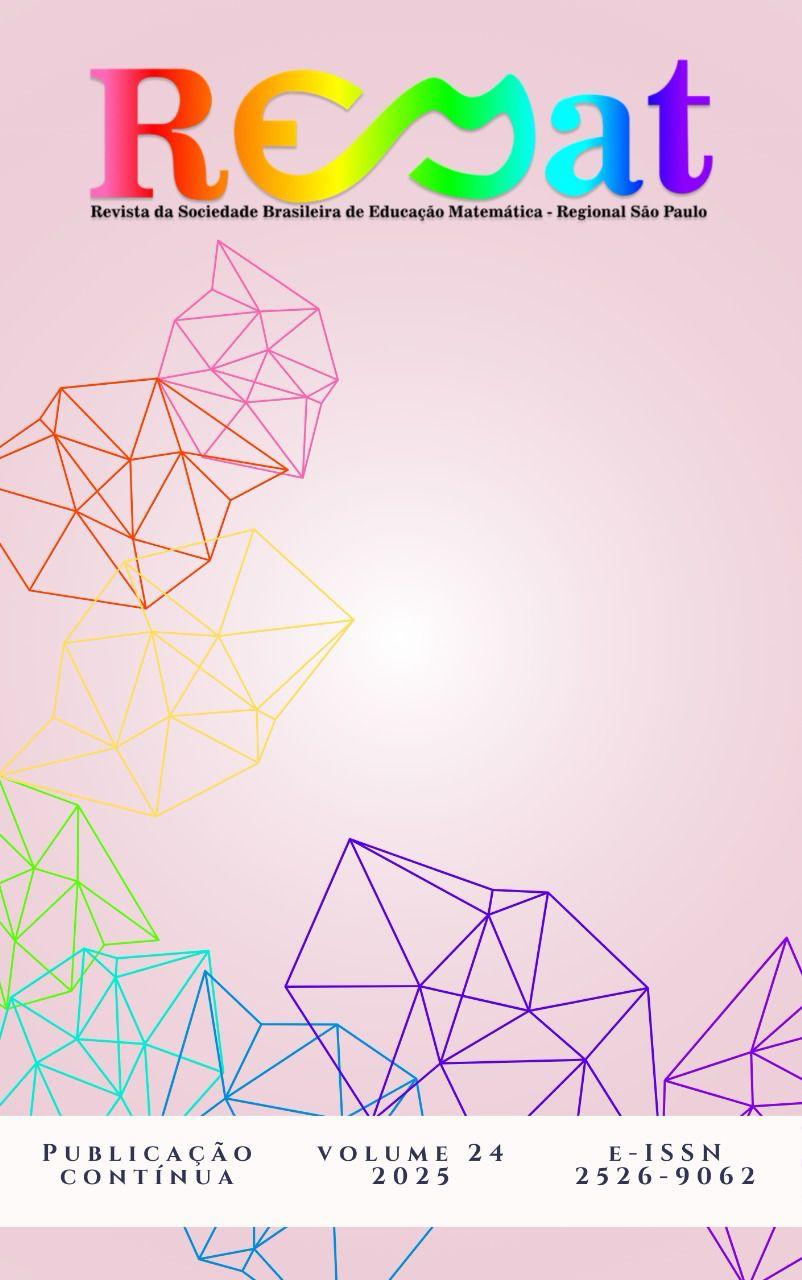Cognição numérica e linguagem em bebês: uma hipótese sobre a sua relação
DOI:
10.37001/remat25269062v24id615Keywords:
Numerical cognition, Language, Generative grammar, MergeAbstract
O texto discute uma hipótese sobre a relação entre cognição numérica e linguagem, a qual foi proposta por um estudioso da Linguística Chomskyana. Inicialmente, é apresentada parte da literatura científica sobre a cognição numérica, com foco em pesquisas com bebês humanos. Comumente, os bebês possuem um sistema de representação exata de pequenos números (até três) e outro de representação aproximada de grandes números. Embora haja consenso quanto ao sistema de representação de números grandes, há divergências com relação ao sistema de representação de números pequenos. O autor da hipótese em discussão considera a existência de duas capacidades humanas: a faculdade da linguagem e a dos números naturais. Ambas possuem em comum o uso de meios finitos para produzir o infinito discreto. Quanto à linguagem, de acordo com a gramática gerativa uma operação computacional chamada Merge permite que as gramáticas, cujos elementos são em número finito gerem um número infinito de expressões linguísticas. O autor propõe que o número gramatical, que, de modo geral, tem palavras equivalentes a um, dois e muitos, reflete o sistema de representação precisa de números pequenos. Quanto aos números maiores, em muitas linguagens se adota uma invenção cultural, qual seja, os sistemas numéricos. Estes surgem quando a operação recursiva combinatória Merge integra os dois sistemas numéricos básicos preexistentes. Ou seja, o Merge faz interface com a faculdade de linguagem, bem como com o sistema de representação exata de números pequenos e com o de aproximação numérica, integrando todos os três. Discute-se a possibilidade de testar empiricamente a hipótese.
Downloads
Metrics
References
ANTELL, Sue Ellen; KEATING, Daniel P. Perception of numerical invariance in neonates. Child Development, p. 695-701, 1983. https://citeseerx.ist.psu.edu/document?repid=rep1&type=pdf&doi=d7cfab15c765c7684ce7a32c744a2f95a7145f17
BERGER, Andrea; TZUR, Gabriel; POSNER, Michael I. Infant brains detect arithmetic errors. Proceedings of the National Academy of Sciences, v. 103, n. 33, p. 12649-12653, 2006. https://doi.org/10.1073/pnas.0605350103
COHEN, Leslie B.; MARKS, Kathryn S. How infants process addition and subtraction events. Developmental Science, v. 5, n. 2, p. 186-201, 2002. https://doi.org/10.1111/1467-7687.00220
COUBART, Aurélie et al. Dissociation between small and large numerosities in newborn infants. Developmental Science, v. 17, n. 1, p. 11-22, 2014. https://doi.org/10.1111/desc.12108
DESTÉFANO, Mariela N. The Problem of Merge. Análisis Filosófico, v. 40, n. 1, pp. 63-91, 2020. https://doi.org/10.36446/af.2020.338
GELMAN, R. (1972). Logical capacity of very young children: Number invariance rules. Child Development. 43, 75-90. https://ruccs.rutgers.edu/images/personal-rochel-gelman/publications/1972LogicalCapacity.pdf
HIRAIWA, Ken. The faculty of language integrates the two core systems of number. Frontiers in Psychology, v. 8, p. 351, 2017. https://doi.org/10.3389/fpsyg.2017.00351
KOBAYASHI, Tessei et al. Baby arithmetic: One object plus one tone. Cognition, v. 91, n. 2, p. B23-B34, 2004. https://doi.org/10.1016/j.cognition.2003.09.004
KOECHLIN, Etienne; DEHAENE, Stanislas; MEHLER, Jacques. Numerical Transformations in Five-month-old Human Infants. Mathematical Cognition, v. 3, n. 2, p. 89-104, 1997. https://citeseerx.ist.psu.edu/document?repid=rep1&type=pdf&doi=98f6d3f41de006de7db110dae068d542dde77cd7
McCRINK, Koleen; WYNN, Karen. Large-number addition and subtraction by 9-month-old infants. Psychological Science, v. 15, n. 11, p. 776-781, 2004. https://doi.org/10.1111/j.0956-7976.2004.00755.x
CLEARFIELD, Melissa Wechsler; MIX, Kelly S. Number versus contour length in infants' discrimination of small visual sets. Psychological science, v. 10, n. 5, p. 408-411, 1999. https://doi.org/10.1111/1467-9280.00177
SHARON, Tanya; WYNN, Karen. Individuation of actions from continuous motion. Psychological Science, v. 9, n. 5, p. 357-362, 1998. https://doi.org/10.1111/1467-9280.00068
SCHLEGER, Franziska et al. Magnetoencephalographic signatures of numerosity discrimination in fetuses and neonates. Developmental Neuropsychology, v. 39, n. 4, p. 316-329, 2014. https://doi.org/10.1080/87565641.2014.914212
SPELKE, Elizabeth S. Core knowledge, language, and number. Language Learning and Development, v. 13, n. 2, p. 147-170, 2017. http://dx.doi.org/10.1080/15475441.2016.1263572
SPELKE, Elizabeth S. What Babies Know: core knowledge and composition. Volume 1. Oxford University Press, 2022. https://doi.org/10.1093/oso/9780190618247.001.0001
STARKEY, Prentice; SPELKE, Elizabeth S.; GELMAN, Rochel. Detection of intermodal numerical correspondences by human infants. Science, v. 222, n. 4620, p. 179-181, 1983. https://www.harvardlds.org/wp-content/uploads/2017/01/starkey1983-1.pdf
STARKEY, Prentice; SPELKE, Elizabeth S.; GELMAN, Rochel. Numerical abstraction by human infants. Cognition, v. 36, n. 2, p. 97-127, 1990. https://doi.org/10.1016/0010-0277(90)90001-Z
STARKEY, Prentice; COOPER JR, Robert G. Perception of numbers by human infants. Science, v. 210, n. 4473, p. 1033-1035, 1980. https://doi.org/10.1126/science.7434014
STRAUSS, Mark S.; CURTIS, Lynne E. Infant perception of numerosity. Child Development, p. 1146-1152, 1981. https://doi.org/10.2307/1129500
XU, Fei; SPELKE, Elizabeth S. Large number discrimination in 6-month-old infants. Cognition, v. 74, n. 1, p. B1-B11, 2000. https://doi.org/10.1016/S0010-0277(99)00066-9
WOOD, Justin N.; SPELKE, Elizabeth S. Infants’ enumeration of actions: Numerical discrimination and its signature limits. Developmental Science, v. 8, n. 2, p. 173-181, 2005. https://doi.org/10.1111/j.1467-7687.2005.00404.x
WYNN, Karen. Addition and subtraction by human infants. Nature, v. 360, n. 6406, p. 768, 1992. https://cte.ku.edu/sites/cte/files/documents/portfolios/green%20hoot/PSYC%20430%20Sample%20in-class%20article%20analysis_checked.pdf
WYNN, Karen. Infants' individuation and enumeration of actions. Psychological Science, v. 7, n. 3, p. 164-169, 1996. https://doi.org/10.1111/j.1467-9280.1996.tb00350.x
WYNN, Karen; BLOOM, Paul; CHIANG, Wen-Chi. Enumeration of collective entities by 5-month-old infants. Cognition, v. 83, n. 3, p. B55-B62, 2002. https://doi.org/10.1016/S0010-0277(02)00008-2
Downloads
Published
Métricas
Visualizações do artigo: 59 PDF (Português (Brasil)) downloads: 71
How to Cite
Issue
Section
License
Copyright (c) 2025 Revista de Educação Matemática

This work is licensed under a Creative Commons Attribution-NonCommercial-NoDerivatives 4.0 International License.


 Português (Brasil)
Português (Brasil)
 Español (España)
Español (España)
 English
English






































